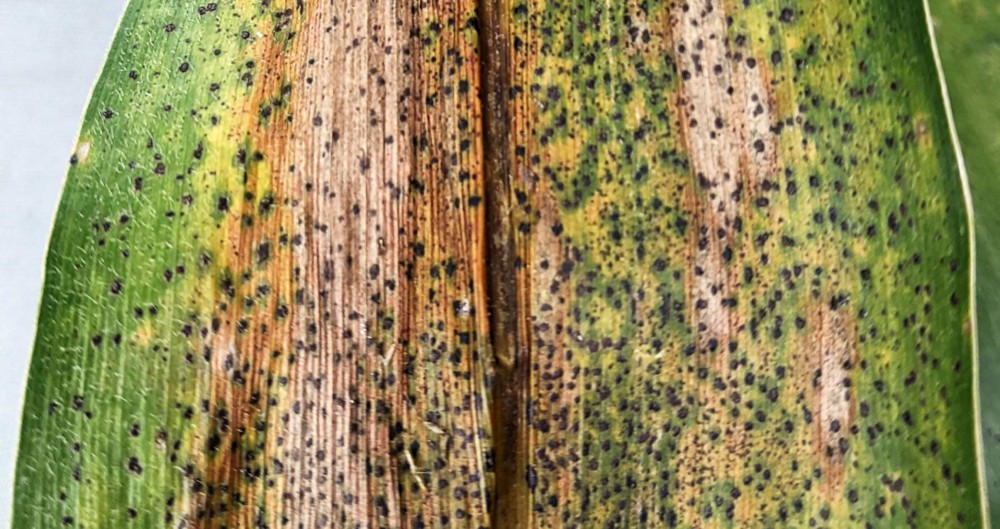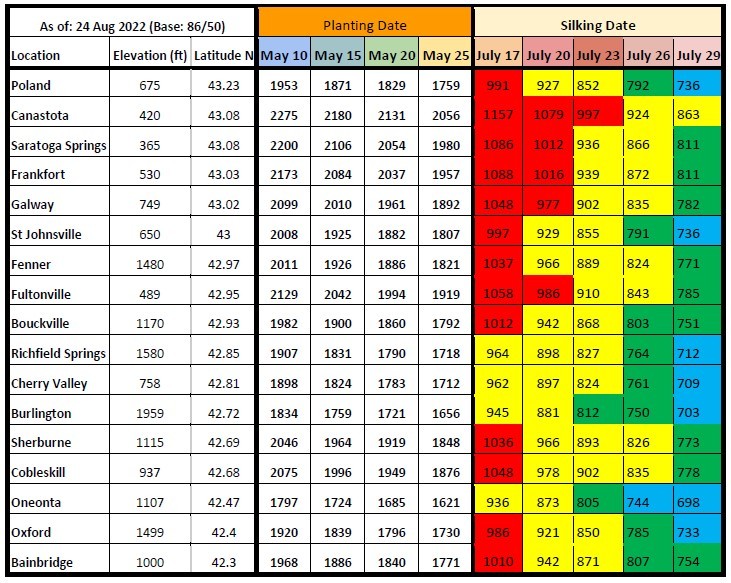Field Crop Update, September 8, 2022
Erik Smith, Area Field Crop Specialist
Central New York Dairy and Field Crops
1. Announcements:
From Gary Bergstrom, Professor of Plant Pathology, Cornell University:
"Tar spot of corn was first observed in New York last fall in two fields in Erie County. The first observation of tar spot in New York in 2022 was confirmed today (9/7/2022) in southwestern Chautauqua County. Tar spot stromata were not evident two weeks ago but are prevalent now on lower and middle leaves and some on upper leaves. Tar spot is more prevalent on field borders than in the center of the field. Recent rains across much of the state have been very conducive for tar spot development wherever spores may be present. Corn is too far along for the disease to affect yield. But we have an opportunity to document the current geographic range of tar spot in the state this year, and that will be helpful in planning management strategies for the future. Now is an excellent time to scout corn fields, especially silage fields that may be harvested soon. Diagnosis is all about finding the raised black fungal stromata (see photo) which cannot be wiped or scratched off the leaf surface as insect frass can. Please contact your local Cornell Cooperative Extension Field Crops Educator if you think you may be observing tar spot stromata. Follow-up leaf samples will be sent to the Bergstrom Lab at Cornell for disease confirmation.":

2. Field Observations
Lots of silage harvest activity happening today and through this weekend. Be safe!
Check your silage crops' whole plant dry matter to make sure you're ready to harvest - your crop may be ready before you know it! See our recent emails regarding Corn Plant Dry Down and Kernel Processing. Here's a reminder from Joe Lawrence (PRO-DAIRY):
"The status of the corn crop is highly dependent on where you are in the state this year but in areas with drought stress (but not complete plant death from drought) it will be really important to watch kernel maturity in combination with whole plant dry matter. In these fields the plants look pretty ugly but the kernels continue to attempt to mature. You will see in the attached that the year and health of the plants makes a difference in how much ear DM contributes to whole plant DM vs. stover DM. For this droughty scenario this could look more like the data from 2019 where the plants are not healthy and therefore contribute slightly more to whole plant DM but ear DM is still driving the dry down process and patience is needed to allow this to happen." Read the full article here.
And to assess the effectiveness of this year's nutrient plan, see this factsheet and this factsheet on the Corn Stalk Nitrate Test.
3. Growing Degree Days as of Aug 31st: See: Climate Smart Farming Growing Degree Day Calculator
Growing degree days (GDD) are calculated by taking the average daily temperature and subtracting the base temperature for development of a given organism ((High + Low)/2 - base temp = GDD). For corn silage, we are using base 50/86, as corn development starts at 50 degrees F and ceases above 86. Check your location, planting date, and silking date. Silage corn needs 750-800 GDD (depending on hybrid maturity) after silking to reach a whole plant DM of 32%. Under typical late season dry down conditions we can expect the crop to reach 35% DM four to seven days later (Remember that we can expect to accumulate 20-25 GDD per day, or even up to 30, so this is not a large window). For more details, see this article. No matter what the numbers say, always check your crop to see how close you may be to harvest:

Blue: Time to make plans (35% DM anywhere between 5 - 11 days from now, depending on maturity)
Green: Gas up the harvester and the trucks (35% DM in 2 - 8 days, depending on maturity)
Yellow: See you in the field (35% in less than a week)
Red: It's either already in the bunk or it's going in the bin or for high-moisture corn (DM likely > 30 - 40%

Field Crop Update, Sept. 8, 2022 (pdf; 627KB)
Upcoming Events
New York State Fiber Conference
June 9, 2024
Bouckville, NY
Theme for this year: Quality Matters
Announcements
Cash Rent and Custom Harvest Survey
To date, there is limited information available about rental rates and fees for crop harvesting. Farms can use this valuable information for their farm business planning to help improve decision making and profitability.Farmers Can Join MeatSuite For Free!
MeatSuite.com is a free resource provided by Cornell University where NY meat farmers can create a farm profile and list their bulk (wholes, halves, quarters) and bundled (i.e. Grilling Bundle) meat products.Why should farmers join?
1. It's free and easy!
2. Connect with more local customers. In the past year the MeatSuite.com farm directory had 8,300 visits from New York consumers. Farm profiles get as many as 25 views per month from potential local customers. We also spotlight MeatSuite farms on social media and bring attention and purchases to farms through highlights and giveaways.
How do I join?
Farmers can visit https://www.meatsuite.com/farmers/ to create a free farm profile. You must list at least one product for your farm's profile to go live. You'll also have access to Cornell's free Meat Price Calculator, a helpful tool for pricing your meat to make a profit.
While you're on MeatSuite, check out the "Creating Consumer-Friendly Bulk Meats" publication on the log-in page. It has tips on how to create bulk meat products that are easier for first-time buyers to say "yes" to.
If you have any questions as you create your farm profile or products, we're here to help! Please email Matt LeRoux at mnl28@cornell.edu.




